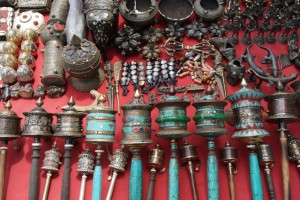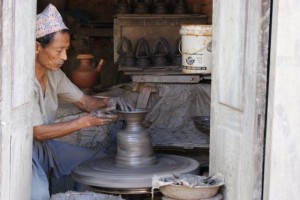From the cooler climes of the verdant heights, I reached the warmer and definitely shriller plains of Kathmandu. The capital of Nepal was overflowing with life, the energy is contagious and the culture-mix, dynamic. From the near-spiritual aloofness of the mountains, the incessant clamour comes as a familiar welcome ritual. As if the city was receiving me back into her bosom with a quivering sigh of happiness. Suddenly I realised how much I had missed this boisterous little imp of a city. And I happily joined the ranks of other seekers and explorers, shoppers and revellers.
Most of the stuff a typical tourist is looking for in Nepal can be found in the touristy by-lanes of Thamel. This backpackers’ paradise is a one-stop shop for anything from outdoor gear to moulded divinity from knitted wear to well, party showers – as announced outside a dance bar not-so-subtly called ‘Pussy Cat’. Everything and everybody was caught in a web of discounts, offers and permanent bargains. Wherever tourists convene, traders converge. So it’s easy to be carried away and confine yourself to Thamel. But that would be the last thing you would want in a city strewn with novel handicraft stores, pottery shops hidden behind great durbar squares, carpets in a refugee centre and traditional paintings everywhere.During the 70s, when ‘all under one roof’ was still a concept in the continent, the Bishal Bazaar rose to be a favoured destination among the elite from India and other neighbouring countries. The genesis of the mall culture booming in Nepal today can be traced back to Bishal Bazaar. Today, this once-iconic destination stands aloof, missing the grand old days, the yesteryear sheen considerably worn off. However, in its struggle to stay relevant in the market, continue to lure customers and stay afloat generally, Bishal Bazaar too has given in to the Chinese invasion sweeping across the globe. As one shopkeeper told me, most of the goods are from Khasa, which meant Chinese. The days of glory could be over for Bishal Bazaar, but it still garners the foot falls to remain a landmark mall.
The purchasing power of the average Nepali in general and the younger lot in particular have gone up in recent years. Thanks to the steadily changing political system and social structure of the country. This is reflected in the tastes and preferences of the fashion-conscious generation. The happening malls are mostly packed with clothing and accessory shops which take its design cues from the popular film industry next door. Branded products, organised retail, loyalty programs…all these might not have made a serious dent in Nepal consumer psyche, yet. Then again, are these really missed in a country with an impeachable lineage of art and culture, craft and tradition? The tourist didn’t seem to – who made a beeline for the umpteen local arts and handicrafts shops and the natural fabric shops for dresses and accessories.Among the handicraft emporiums of Kathmandu, the Sana Hastakala in Kopundole Road is a pioneer. This founder member of the Fair Trade Group Nepal, also strives to preserve traditional crafts and to uplift underprivileged craftsmen. Set up in 1989 with financial and technical support from Unicef, the objective was to open up new marketing opportunities for women handicraft producers who didn’t have any sales outlet. Sana Hastakala is known for its exquisite bead jewellery and accessories. Dhukuti, an equally well-stocked outlet like Sana, is a short walk away. The folk art of Nepal is a thriving industry today. The original inhabitants, the Newars, were gifted craftsmen. Their legacy continues to this day in the handmade paper products, traditionally spun takkas, white metal cutlery, horn utensils, the Khukuris which are symbols of ‘veer Gorkhari’ and jewellery made of bone and semi precious stones.
No visit to Nepal will be complete without bringing home a thangka painting. This is essentially a scroll painting favoured for its ease of transport. These paintings, used mostly for worship, are also used for teaching as well as decoration. The thangka paintings capture different gods in their various mood swings ranging from anger to benevolence. The paint used for traditional thangka paintings are made of vegetable and mineral dyes. In more expensive works, gold-based colours are also used. These paintings are definitely worth taking back with you – essentially stylised symbolisms condensing the rich and colourful mythologies and legends of Nepal. The clay vessels, historical figures and religious motifs are slices of ethnic Nepal – the best samples of which can be found in the Potter’s Square of Bhaktapur. These are usually made from black clay both as sun-baked terracotta and glazed earthenware in furnaces to gives it lustre, colour and quality. However, unlike the thangka paintings, transporting these can pose a problem. But the sellers will agree to pack and ship it out to you for an additional price.While Nepali art and craft are thriving in the valley, ironically the biggest employer in the region is an import from Tibet. The carpet centre at Jawalakhel is synonymous with the Tibetan Refugee Centre. Since its inception in 1960 as a shelter for Tibetans fleeing Chinese occupation, the centre has become the principal forex earner of Nepal. The weaving uses two types of sheep wool – Tibetan and New Zealand. Those woven from Tibetan wool is warmer while New Zealand wool gives more lustre. The centre also does customised carpet weaving as per specifications. The carpets made from hand spun wool have a unique lustre and softness and are coloured with vegetable dyes. The designs are mostly inspired from Tibetan legends. The Jawalakhel Carpet Centre manufactures three types of carpets – 100, 80 and 60 knots. The centre also doubles up as a showroom from where you can buy carpets, place your orders which will be shipped or give your specifications for customisation in design, blend or size.
Good buys are almost always a testimony to your bargaining skills. However, when buying traditional handicrafts, especially expensive ones, it is prudent to take along a local with an expert eye. Tales abound of unscrupulous shopkeepers passing off junk as antique or charging unheard-of prices. A word of caution here: Do not be carried away when somebody tries to sell you a handicraft item which is over 100 years old. Any handicraft which is 100 years or older is classified as ‘antique’ by the Nepalese government and taking them out of the country is a punishable offence.Knick-knack curios from the numerous shops of Thamel, religious motifs sold in the durbar square stalls, colourful and functional handicrafts from folk art shops, souvenirs that are expensive or just showpieces, decorative items of lasting value – the options are many for your piece of Nepal to take home.
















